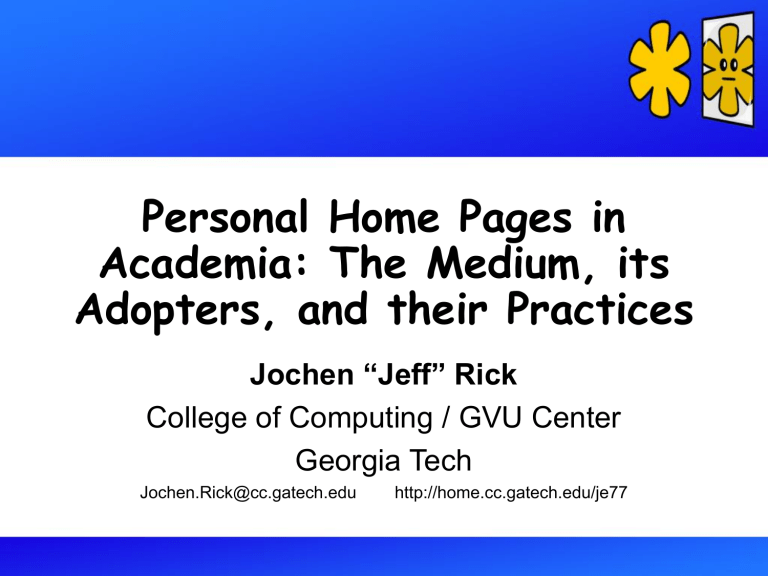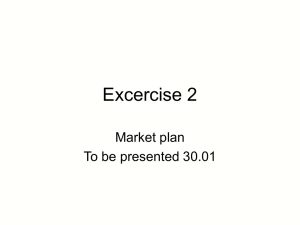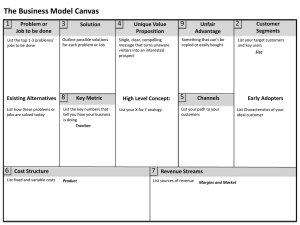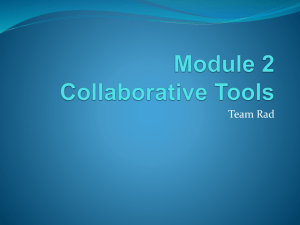Personal Home Pages in Academia: The Medium, its Adopters, and their Practices

Personal Home Pages in
Academia: The Medium, its
Adopters, and their Practices
Jochen “Jeff” Rick
College of Computing / GVU Center
Georgia Tech
Jochen.Rick@cc.gatech.edu http://home.cc.gatech.edu/je77
Outline
• Motivation (Personal Home Pages are
Important)
• Software (Motivating and Introducing
AniAniWeb)
• Research Details / Findings
• Design Issues
• Conclusion
Introduction | Motivation | Software | Research Findings | Design Issues | Conclusion
Personal Home Pages are
Important
• Historical Importance
• Personal home pages are one of the first established uses of the Web.
• Personal home pages are the first uniquely digital genre (Dillon and Gushrowski, 2000).
• Looking Forward
• Increasingly, they serve vocational purposes.
• The technology to support web authoring is improving.
Introduction | Motivation | Software | Research Findings | Design Issues | Conclusion
One Site:
The Owner’s Use
Introduction | Motivation | Software | Research Findings | Design Issues | Conclusion
One Site:
Academic Visits
Introduction | Motivation | Software | Research Findings | Design Issues | Conclusion
One Site:
Other Visits
Introduction | Motivation | Software | Research Findings | Design Issues | Conclusion
Static Personal Home
Pages
• Problems
• Content Creation is not
Emphasized
• Publication is Awkward
• Interaction is not
Facilitated
• A Survey of Adopters in 2003
• How do we address these shortcomings?
Web: Publication Model
Introduction | Motivation | Software | Research Findings | Design Issues | Conclusion
WikiWikiWeb
• They solve many of the problems of static personal home pages:
• Content creation is emphasized by a focus on creating (hyper)text.
• Publication is made simple by a quick (wiki wiki) editing cycle.
• People have been using wikis to collaborate and interact (e.g., CoWeb,
Wikipedia).
Wiki: Democratic Model
Introduction | Motivation | Software | Research Findings | Design Issues | Conclusion
But, wikis have their own problems.
• Disadvantages (for Personal Home Pages)
• Wikis are too open.
• A personal home page needs more protection.
• There is a person in charge: the owner.
• Home-page adopters need more support for looks.
• Wikis look more like wikis (e.g., a prominent edit link) than a personal home page.
• A personal home page should be customizable, so that its owner can create a look that represents him or her.
Introduction | Motivation | Software | Research Findings | Design Issues | Conclusion
AniAniWeb
• It uses wiki editing for content creation.
• Utilize a hierarchical structure to organize content.
• It supports a standard home page look that can be customized.
• Its access-control model is a combination of secure and open.
AniAniWeb: Home Model
Introduction | Motivation | Software | Research Findings | Design Issues | Conclusion
Technological Hypotheses
1.
Wiki features (quick authoring, interaction support, and collaboration support) can enhance the authoring of personal home pages over traditional (static) tools by better supporting established uses and making new uses possible.
2.
Wiki technologies need to be augmented with more access control , more structure , and more support for customizable looks to better support the authoring of personal home pages.
Introduction | Motivation | Software | Research Findings | Design Issues | Conclusion
Sign-in
Viewing an
AniAniWeb
Introduction | Motivation | Software | Research Findings | Design Issues | Conclusion
Edit
Viewing an
AniAniWeb
Introduction | Motivation | Software | Research Findings | Design Issues | Conclusion
Editing an
AniAniWeb
Introduction | Motivation | Software | Research Findings | Design Issues | Conclusion
Data Collection
• Fall 2003
• AniAniWeb is Introduced
• 1.5 Years Later - 2 Years Later
• Graduate students that use the AniAniWeb heavily are recruited for the research and interviewed.
• Faculty members are interviewed to complement student interviews.
• Sanity-check follow-up interviews are conducted.
• The system is significantly updated, based on the information provided in the interviews.
Introduction | Motivation | Software | Research Findings | Design Issues | Conclusion
Research Findings
• As a still evolving medium, there are several technological frames by which people author and view personal home pages: the professional academic home page, the indiscreet home page, an organizational repository, and the home page as mirror.
• The use of personal home pages changes throughout an adopter’s journey from the periphery to the core of the academic community of practice.
• As a self-presentation tool, personal home pages can allow some adopters to reflect on and actively construct their identities.
• Personal home pages naturally lead to a multiple audience problem.
Introduction | Motivation | Software | Research Findings | Design Issues | Conclusion
Research Findings
• As a still evolving medium, there are several technological frames by which people author and view personal home pages: the professional academic home page, the indiscreet home page, an organizational repository, and the home page as mirror.
• The use of personal home pages changes throughout an adopter’s journey from the periphery to the core of the academic community of practice.
• As a self-presentation tool, personal home pages can allow some adopters to reflect on and actively construct their identities.
• Personal home pages naturally lead to a multiple audience problem.
Introduction | Motivation | Software | Research Findings | Design Issues | Conclusion
The Multiple Audience
Problem
• A personal home page on the Web is open to anyone.
• A search engine treats everyone the same.
• Viewers can fall into many categories.
Introduction | Motivation | Software | Research Findings | Design Issues | Conclusion
The Multiple Audience
Problem
• A personal home page on the Web is open to anyone.
• A search engine treats everyone the same.
• Viewers can fall into many categories.
• These categories often overlap.
• Different content is appropriate to different audiences.
• Is this a problem?
Introduction | Motivation | Software | Research Findings | Design Issues | Conclusion
Is this a problem?
• For smaller sites, such as I observed in my survey of static personal home pages, it is not much of a problem.
• For participants in this research, it was a problem.
• Because it was easy to edit content, AniAniWeb users created more (3 times) content.
• The interactive features made it a convenient medium for new activities.
Introduction | Motivation | Software | Research Findings | Design Issues | Conclusion
The Multiple Audience
Problem in Academia
• What is acceptable to academia?
• Some Non-Professional Content
• Some Like It
• Furthers Integrative Trends
• What is not acceptable to academia?
• “Goofy” Unprofessional Content
• Controversial Content (i.e., politics, sex, religion, drugs, etc.)
Introduction | Motivation | Software | Research Findings | Design Issues | Conclusion
The Multiple Audience
Problem in Academia
• The Result: The Polite Home Page
• Home Pages that Integrate Concerns
(professional, personal, etc.)
• But, that content is censored to be polite.
• Different adopters have different standards.
• Thus, authors limit content to be more polite than they find acceptable.
Introduction | Motivation | Software | Research Findings | Design Issues | Conclusion
Implications of the
Multiple Audience Problem
• Towards a Global Village
• “Electric circuitry has overthrown the regime of
‘time’ and ‘space’ and pours upon us instantly and continuously the concerns of all other men. It has reconstituted dialogue on a global scale.”
(McLuhan and Fiore, 1967)
• The Need for Access Control
• There is a need to manage the multiple audience problem.
Introduction | Motivation | Software | Research Findings | Design Issues | Conclusion
Design Issues, Revisiting
Technological Theses
• Use of Wiki
• Authoring Content
• Interaction / Collaboration
• Beyond Wiki
• Designing Looks
• Access Control
• Structure
Introduction | Motivation | Software | Research Findings | Design Issues | Conclusion
Authoring Content
• Wiki editing made it much easier.
• Wiki syntax is useful.
• More Content
• Static Sites: 12 HTML pages
• AniAniWeb: 39 pages
• High Revision
• Professional Home Page
• 10 edits a month, 9 edit cycles per page
• Significant Self Use
• 37 edits a month, 25 edit cycles per page
Introduction | Motivation | Software | Research Findings | Design Issues | Conclusion
Interaction /
Collaboration
• Low Compared to Wikis
• Important for Motivation and New Uses
• Social Barriers
• “Who am I to edit your home pages?”
• Technological Barriers
• Access-control barriers make it difficult.
• Keys to Successful Interaction
• Lightweight and Set Up
• Keys to Successful Collaboration
• Privacy
Introduction | Motivation | Software | Research Findings | Design Issues | Conclusion
Designing Looks
• The AniAniWeb Looks System
• Site owners can add graphic files and edit a CSS file to modify a fairly standard look for personal home pages.
• Several adopters succeeded.
• You can’t please everyone.
• Some wanted more control of CSS.
• Others would have preferred a simpler system.
• Adopters need a good beginning look.
Introduction | Motivation | Software | Research Findings | Design Issues | Conclusion
Designing Looks
• The AniAniWeb Looks System
• Site owners can add graphic files and edit a CSS file to modify a fairly standard look for personal home pages.
• Several adopters succeeded.
• You can’t please everyone.
• Some wanted more control of CSS.
• Others would have preferred a simpler system.
• Adopters need a good beginning look.
Introduction | Motivation | Software | Research Findings | Design Issues | Conclusion
Access Control
• It is vitally important.
• It must satisfy multiple complex goals.
• A Simple Interface
• Useful Learning Curve
• Supports a Wide Range of Users
• The Owner
• Strong Ties, Weak Ties, Latent Ties
• Different Categories
• Supports a Wide Range of Uses
• Limiting Viewing Access
• Enabling Access Beyond Viewing
Introduction | Motivation | Software | Research Findings | Design Issues | Conclusion
Access Control
• Solution: Access Control Groups
• Default Groups
• Anonymous Visitors
• Signed-in Users
• Create New Groups
• It must be easy for visitors to gain access.
• Keywords
• Knowing the URL
• IP Addresses
Introduction | Motivation | Software | Research Findings | Design Issues | Conclusion
Structure
• Useful for Organization
• A page hierarchy works on a small scale.
• Users were able to manage this easily.
• Side Effects of Dividing the Space
• Looks (Personal Section)
• Access Control (Access by Section)
Introduction | Motivation | Software | Research Findings | Design Issues | Conclusion
Final Thoughts:
Authoring on the Web
• “As we look at the way a person uses the Web, it is simplest to improve the reception of information by adding new forms of graphics and multimedia. It is more difficult to imagine how best to allow a person to interact with the information, to create and modify it. Harder still is imagining how this computer screen can be used to allow one person to interact as one of many people interacting as a group. This is the order in which development has occurred to date, and will occur in the future.” (Berners-Lee, 1998, p. 160)
Introduction | Motivation | Software | Research Findings | Design Issues | Conclusion
Acknowledgements
• Research Participants
• Committee
• Mark Guzdial, Chair
• Marina Umaschi Bers, Tufts University
• Amy Bruckman
• Janet Kolodner
• Beth Mynatt
• Fellow Students (CSL, LST, etc.)
Introduction | Motivation | Software | Research Findings | Design Issues | Conclusion
Findings / Contributions
1.
This case study conveys the potential use and meaning of personal home pages, by studying adopters of that new medium in an authentic context
(academia) and supporting their use with an advanced tool (AniAniWeb).
2.
AniAniWeb is a concrete embodiment of the design principles for supporting personal home pages in academia.
3.
This research identifies the importance of the multiple audience problem to personal home pages, shows how the problem develops and its ramifications, and suggests how technological features (mainly access control) can help adopters to address it.
4.
This case study establishes several technological frames by which people author and view personal home pages: the professional academic home page, the indiscreet home page, an organizational repository, the home page as mirror.
5.
This case study details how the use of a medium (personal home pages) changes throughout an adopter's journey from the periphery to the core of a community of practice (academia).
6.
This research shows how personal home pages, as a self-presentation tool, can be a reflective medium, allowing for some adopters to reflect on and actively construct their identities.
Motivation | Software | Case Study | Research Findings | Design Issues | Conclusion






